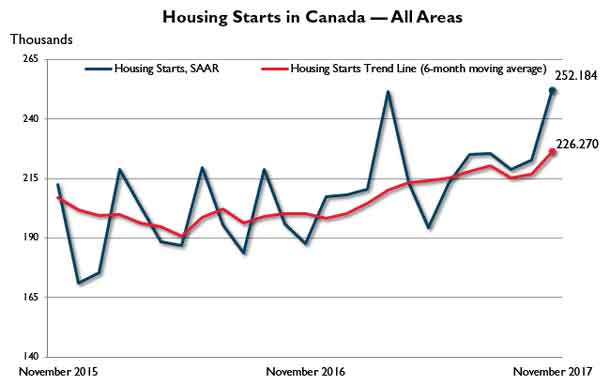THUNDER BAY – The trend in housing starts was 214,821 units in September 2017, compared to 220,573 units in August 2017, according to Canada Mortgage and Housing Corporation (CMHC). This trend measure is a six-month moving average of the monthly seasonally adjusted annual rates (SAAR) of housing starts.
“Housing starts are trending lower in September after increasing for eight consecutive months,” said Bob Dugan, CMHC’s chief economist. “Nevertheless, new home construction remains very strong as the seasonally adjusted number of starts was above 200,000 units for four straight months.”
Monthly Highlights
St. John’s
Drivers such as population, income and employment have put downward pressure on new home construction activity. Total housing starts fell 34% in September compared to the prior year. Single-detached starts declined 33%, while multiple starts declined 42%.
Prince Edward Island (PEI)
Tightness in PEI’s resale sector continues to cause demand to spill over into the Island’s new home market. Starts of single-detached homes were up 93% year-to-date in September, with most of the activity concentrated in the Charlottetown area. Record high levels of international migration continue to support starts of multi-family dwellings, which were up 16% year-to-date.
Quebec
In the third quarter of 2017, the annual rate of housing starts for the province overall reached 43,736 units, up from the level registered for the previous quarter (40,564 units). This last result, as were the relatively high totals for the previous quarters, was attributable to the strong momentum observed in the multi-unit housing segment, particularly in the case of rental apartments, for which starts remained significant in the Montréal and Québec areas. Given the strong activity observed so far, Quebec starts will likely post a gain in 2017.
Toronto
Homebuilders broke ground on fewer homes in the Toronto Census Metropolitan Area (CMA) during September 2017. Total housing starts trended lower by 7% in September from the previous month led by lower apartment starts. Monthly variations in high-rise starts are typical given delays in getting large scale projects off the ground. Low-rise starts remained strong. The overall pace of new home construction remains stable as strong demand for new homes in the Toronto CMA continues to persist.
Brantford
Single-detached starts were high in Brantford in September. New single-detached homes in Brantford were selling for $550,000 to $700,000 early this year, attracting the growing number of households from Hamilton and the GTA who could no longer afford detached homes in their markets.
London
Both single-detached and multiple housing starts in London CMA posted the highest levels for the month of September since 2006. Strong population growth and recent income gains have strengthened demand for new single-detached homes – encouraging builders to continue to keep single-detached starts elevated over recent months.
Saskatoon
Total housing starts trended lower in September after production of both single-detached and multi-family units slowed. While the pace of construction in the singles sector has been on par with last year, multi-family construction was down 30% after nine months this year. Elevated inventory of completed and unsold condo apartments have remained a drag on this sector. All told, total year-to-date housing starts in September were down 13%, compared to the same period a year ago.
Vancouver
Housing starts in the Vancouver CMA trended downwards in September as fewer multi-family home projects got underway. The high level of housing starts over the past year has led to a record number of units being under construction in the region, leaving little spare capacity to start additional projects. New home construction in the Vancouver CMA is being supported by population growth, a strong local economy, and low financing costs.
CMHC uses the trend measure as a complement to the monthly SAAR of housing starts to account for considerable swings in monthly estimates and obtain a more complete picture of Canada’s housing market. In some situations analyzing only SAAR data can be misleading, as they are largely driven by the multi-unit segment of the market which can vary significantly from one month to the next.
The standalone monthly SAAR of housing starts for all areas in Canada was 217,118 units in September, down from 225,918 units in August. The SAAR of urban starts decreased by 5.1 per cent in September to 198,910 units. Multiple urban starts decreased by 10.7 per cent to 131,388 units in September. Single-detached urban starts increased by 8.2 per cent, to 67,522 units.
Rural starts were estimated at a seasonally adjusted annual rate of 18,208 units.







